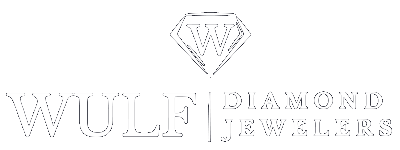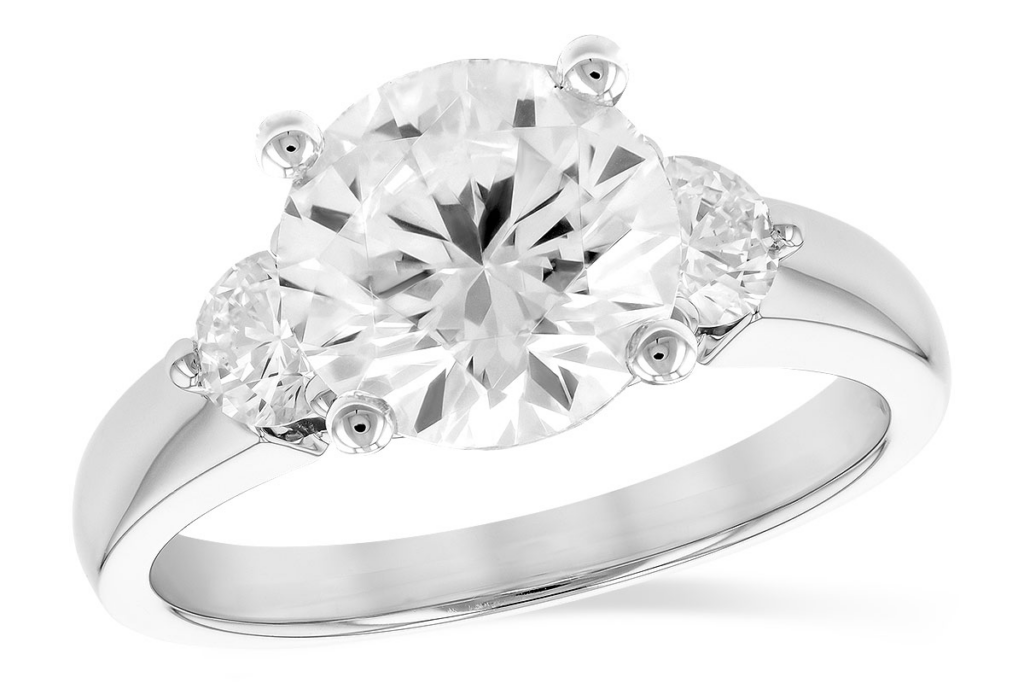Since mined diamonds are scarce and not to mention, expensive, the search and market for diamond alternatives arise. And that’s why we have simulated diamonds.

Simulated Diamonds are stones created to simulate the look of a diamond. Unlike diamonds, which are made up of pure carbon, these diamond simulants have different chemical compositions which affect their physical and optical properties.
Visit our gallery of calibrated-faceted gemstones
Properties to look for a Simulated Diamond
Because simulated diamonds are created to mimic the look and feel of a real diamond, the following characteristics are used to measure its quality.
Related read: Why Are Pearls so Expensive? Your Complete Guide to Buying Pearl and Pearl Jewelry
Hardness
Hardness refers to how “scratch-proof” a gem is.
Diamonds are the hardest natural substance on earth, with a Mohs rating of 10. Therefore, any other gemstones have lower ratings, which means that they will develop scratches by gems harder than them. This will affect the brilliance and luster of the simulant.
Brilliance
The brilliance (or the sparkle) is obtained from three properties: Reflection, Refraction, and Dispersion.
- Reflection is how the light hits a stone and is bounced back to the eyes.
- Refraction is how light passes through the stone and is scattered and fractured, and
- Dispersion is how white light is broken down to its rainbow colors.
One of the reasons diamonds are popular and expensive is how light affects diamonds. While others can closely copy the same brilliance effect of a diamond (Moissanite), others don’t get much. This is mainly due to the chemical composition of the stone.
Brilliance is often measured by its refractive index – it is how a gemstone bends light. The higher the refractive index is, the more light is bounced back, therefore the more sparkly it is.
Fire Dispersion is also used. It is the way light bounces back rainbow colors.
Color & Clarity
Just like Diamonds, different stones have different clarity. However, since simulated diamonds (not lab-grown or mined diamonds) are man-made, most can get a perfect or near-perfect grade. Cubic Zirconia for one does not have any imperfections.
Diamonds have varying colors, which range from D-Z. On the other hand, Diamond simulants may or may not follow this grading system. Some are just measured by type or hue.
Related Read: How to Identify a Black Diamond: Is It Real or Fake?
Price
Generally, mined diamonds are the most expensive stones out there. Synthetic diamonds (otherwise known as lab-grown diamonds) are the more affordable version. Regardless, diamonds are more expensive than other stones.
The rule of thumb is natural stones are more expensive than lab-created ones. However, depending on nature or characteristics, some may be more expensive than synthetic ones.
Comparison between Diamonds and Diamond Simulants


Diamond vs. Lab-grown Diamonds
To clarify, Lab-grown diamonds are not simulated diamonds. As a matter of fact, lab-grown diamonds are classified as real diamonds.
The only difference between these 2 is where they are obtained/created. Diamond (or mined/natural diamonds) are acquired through mining, while lab-created diamonds are grown in laboratories. All other characteristics, the 4Cs, are the same. They are also graded 10 on the Mohs hardness scale.
Related Read: Most Expensive Jewelry Sold at An Auction in 2021
Moissanite vs. Diamond
Moissanite is a stone made of silicon carbide. Naturally-occurring moissanite is rare and can only be found in few rocks from the upper mantle, meteorites, and as inclusion in rocks where diamonds are found.
Thankfully, Moissanite can be synthesized in laboratories. All Moissanites used in jewelry are lab-created.
Overall, Moissanite, with its hardness and brilliance, is a good alternative to diamond engagement rings and other jewelry. And since Moissanite is lighter than diamonds, you can get a bigger stone for the same carat weight
Read: 4-carat and 5-carat engagement rings
Hardness
While diamonds are rated 10 on the Mohs scale, Moissanite is at 9.25, an excellent alternative and good for everyday wear. In fact, the only gemstone that will scratch it is a diamond.
Brilliance
This will come as a surprise, but did you know that moissanite is more brilliant than diamonds?
This is so because Moissanite has a higher refractive index (2.65 vs diamond of 2.42). It also has a higher fire dispersion (0.104 vs diamond of 0.044), which means that it reflects more white and colored light.
If you are after a stone that has more sparkle, Moissanite is your best bet.
Color and Clarity
Moissanite can come in different colors and follows the same diamond color grading system. And while moissanite is completely different from diamonds, good quality moissanite is hard to differentiate from a diamond.
Price
Moissanite is more affordable than diamonds. You may find a 1-carat round cut moissanite priced around $800.
White Sapphire vs. Diamond
Sapphires are part of the corundum family and can come in varying colors. Red sapphires are called rubies; all other colors are called sapphires.
If you want something more affordable while not minding the muted brilliance, then white sapphire is a good alternative
Hardness
Sapphires are rated 9 on the Mohs scale, making them scratch-resistant compared to other gemstones. Only stones in the higher scale can induce scratches.
If you are not planning to scratch your jewelry against each other, this stone is good for you.
Brilliance
While diamonds have great contrast and have a “rainbow” sparkle, white sapphires have a more muted white brilliance. It does not have the high contrast Diamonds and Moissanites have.
If you want to get the most out of white sapphires, getting a small, round-cut shape is your best option.
Color and Clarity
Depending on the cut, white sapphires can have a clear to milky to silver appearance, unlike Diamonds or Moissanites which are colorless with a faint tint depending on the color grade.
Look also for white sapphires that are close to colorless as possible and are eye-clean. Eye clean means that any flaws or inclusion are not visible to the naked eye.
Price
White sapphires are more affordable than diamonds. A 1-carat white sapphire is priced around $700+.
Cubic Zirconia vs. Diamond
Cubic Zirconia (CZ) is a synthetic gemstone made of zirconium dioxide. It has gained popularity, especially in the jewelry industry because it can mimic the sparkle of a diamond at a very affordable price.
Cubic Zirconia is usually set in S925 silver or gold-plated silver, making jewelry with this stone available at low price points.
Cubic Zirconia is different from Zircon, though. Zircon is a naturally occurring gem commonly seen in sands. While its appearance is similar to Cubic Zirconia, Zircon is actually softer (7 on Mohs scale), more brittle, and more expensive.
Hardness
Cubic Zirconia is rated at 8.5. Therefore, this is not as scratch-proof as its counterparts (Diamonds and Moissanites) and will easily chip off when hit with pressure. This will make Cubic Zirconia lose its brilliance over time.
Brilliance
When it comes to brilliance or sparkle, Cubic Zirconia is as close as you can get to Diamonds and Moissanites. It also emits rainbow flashes and reflects light better than sapphires and other gemstones of lower hardness. This is why most fancy jewelry has CZ as its main stone.
Color and Clarity
This is a colorless stone, similar to diamonds with a DEF rating. This is different than diamonds where color may range from the most expensive D color to a lower color grade.
CZ is also flawless, meaning you won’t find any inclusion in the gemstone. By contrast, flawless, real diamonds are rare, not to say, very expensive.
Price
As to the price, cubic zirconia is more affordable than diamonds 1 carat round CZ will cost starting at $6+.
Investment-wise, CZ will not hold any value; the reason why CZ is usually mounted in lower-value metals such as silver.
White Topaz vs. Diamond
The name topaz may come to us from the Sanskrit word “tapaz” or “topas” meaning fire. It has a long history of use as an affordable option to diamond. According to lore, it dispels anger and assures long life, beauty, and intelligence.
Topaz is a semi-precious stone that is made of aluminum and fluorine. Topaz can come in different colors, but it is colorless in its purest form. White topaz is a good alternative to white/glass-like stones, not necessarily Diamonds or Moissanites because of the difference in brilliance and hardness.
Hardness
White topaz is at 8 at the Mohs scale, making it softer than Moissanites and even Cubic Zirconia. While it is hard, it is not recommended to be worn on a daily basis
Brilliance
White Topaz’s brilliance is similar to white sapphire’s than diamonds. It also has muted white sparkle that lacks fire dispersion.
Since it is softer than CZ and moissanite, the scratches it will get over time will affect how light is reflected and refracted. Thus, white topaz will not be as brilliant as when you first purchased it.
Color and Clarity
In its purest form, topaz is actually colorless. Any tint or hue comes from inclusions.
If you want to get Topaz as a stone, get one that is eye-clean (see our Topaz Notable Gem Collection)
Price
White Topaz is more affordable than Diamonds, Moissanites, and Sapphires but is more expensive than Cubic Zirconia. An 8mm white topaz is priced at $50+.
Morganite vs. Diamond
This gorgeous pink beryl is a cousin of emerald and aquamarine. In smaller sizes, morganite has a delicate look. Larger stones have a richer shade for a bold, sophisticated look. Morganite reduces stress, stimulates calm, brings wisdom, and gives purpose to our lives.
It has become popular because of its resemblance to pink diamonds.
Morganite is softer and lacks the brilliance of Moissanites and Diamonds, but are good alternatives if you don’t mind having a muted sparkle. However, because morganites are softer than their more common counterparts, it is not advisable to be used for everyday wear, or if ever used, special care must be taken.
Hardness
Morganite has a rating of 7.5 – 8; which is fairly hard and decent and can be worn as jewelry. However, they are brittle and can chip from impact.
Brilliance
Morganite is not comparable to Diamonds, Moissanites, and CZ when it comes to brilliance. Because of its chemical composition and properties, its sparkle is more similar to topaz and sapphires.
Color and Clarity
Morganite comes in romantic hues of violet and pink. Morganites closer to pink hues are gaining popularity because of their resemblance to pink diamonds. Morganites with richer color hues are more expensive than fainter ones.
Just like sapphires and topazes, get morganites that are eye-clean.
Price
Depending on the cut and color, a high-quality pink morganite can cost $900 per carat.
Quartz vs. Diamond
Quartz is a form of crystal or mineral that is abundant and quite common. Because of its appearance, quartzes are previously thought of as fossilized ice.
While quartz is becoming popular in jewelry, it is more often used for healing, as countertops, or as decorative pieces. Quartz is quite soft and is not recommended for everyday wear.
Hardness
It is rated with a Mohs scale of 7; meaning, this crystal is extremely soft and will easily scratch. As a matter of fact, it has the same hardness as regular dust (silica).
Having Quartz as a replacement for diamond engagement rings is quite rare and is not advisable since it will not endure the regular wear and tear of everyday use.
Brilliance
Quartz reflects light through its natural luster and not because of how the stone reflects or disperse light. This makes quartz not an ideal substitute for any brilliant stones ideal for jewelry.
Color and Clarity
Quartz comes in different colors and depending on the color, may have different names. We have rose quartz (pink), amethysts (purple quartz), Citrine (yellow quartz). Quartz can be transparent to completely opaque.
Just be sure that by getting quartz jewelry, get something that is eye-clean without any visible flaws and inclusions.
Price
Quartz is inexpensive. You can buy 1 carat of jewelry-grade quartz as low as $17/carat
FAQs about Simulated Diamonds
Do Simulated Diamonds Get Cloudy?
Depending on the stone that you choose some are cloudier in appearance than others. Sapphires and Topaz can be cloudy in appearance, all depending on the inclusions and flaws that these stones have.
Moissanites and Cubic Zirconia are flawless and colorless/nearly colorless, making them a good substitute for diamonds.
What is a simulated diamond worth?
All simulated diamonds are cheaper than real diamonds. Depending on the stone, it can range from as low as $17 to the precious stones ranging from $700+/carat. Check and compare the prices of precious and semi-precious stones by AaLAND.
What is the best simulated diamond in the market?
The best diamond alternative you can get is Moissanites. They are more brilliant than Diamonds, sturdier than other precious and semi-precious gemstones, and are reasonably affordable (compared to diamonds).
Diamond simulants are being used as an alternative to diamond engagement rings. It all depends on your/your partner’s lifestyle and preference.
How to clean simulated diamond rings and jewelry?
Cleaning simulated diamonds can be tricky, especially for the softer gemstones, and stones that react to light and other chemicals.
Diamonds and Moissanites can be cleaned professionally by your trusted jeweler. The same goes for other precious stones such as sapphires and morganites. However, Cubic Zirconia jewelry is relatively cheap and can be cleaned using running water and gentle soap.








